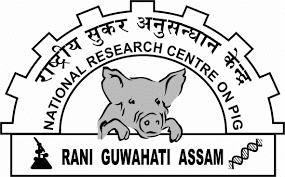|
1.
|
AICRP on pig started its journey during IVth five year plan (1970-1971) with the main objective of studying the performance of purebred exotic pigs under existing managemental conditions at the following research centers: |
|
I.
|
ANGRAU, Tirupati, Andhra Pradesh |
|
II.
|
AAU, Guwahati, Assam |
|
III.
|
JNKVV, Jabalpur, Madhya Pradesh |
|
IV.
|
IVRI, Izatnagar, Uttar Pradesh |
|
In 1992-93, two more centres at Kattupakam (Tamilnadu) and Mannuthy (Kerala) was added in the AICRP network. During the year 2000-2001, two more centres at ICAR Research Complex, Goa and BAU, Ranchi were started to study the performance of indigenous pig for two generations followed by their crossbreeding with Large White Yorkshire boars. During the XI plan two more centres of AICRP were approved, namely College of Veterinary Science (CAU) at Aizawl, Mizoram and Nagaland University, Medziphema. JNKVV, Jabalpur, Madhya Pradesh center was discontinued from AICRP programme since April, 2013. Most recently, during the XII plan five more new centers were approved and started functioning in 2014-15. All existing AICRP centres on pig as listed below are coordinated by ICAR-NRC on Pig. |
|
|
•
Assam
Agricultural University, Khanapara, Guwahati • Birsa Agricultural University, Kanke, Ranchi • Kerala Veterinary and Animal Science University, Mannuthy • Sri Venkateswara Veterinary University, Tirupati • Tamilnadu Veterinary and Animal Science University, Kattupakkam • Indian Veterinary Research Institute, Izatnagar • ICAR Research Complex for Goa, Old Goa. • Central Agricultural University, Aizawl, Mizoram • SASARD, Nagaland University, Medziphema. • Krishi Vigyan Kendra, NRC on Pig, Dudhnoi, Goalpara, Assam • Central Agricultural Research Institute, Port Blair, Andaman and Nicobar Island • Central Agricultural University, Imphal, Manipur • Indian Veterinary Research Institute, Eastern Regional Station, Kolkata, West Bengal • ICAR Research Complex for NEH Region, Tripura Centre, Agartala, Tripura • ICAR Research Complex for NEH Region, Barapani, Shillong, Meghalaya |
|
| ICAR-NRC on Pig is engaged in coordinating the research and development of the AICRP centers both in terms of technical and financial aspect in consultation with Council. |
|
2.
|
Original objectives and modification thereof: |
|
|
During
IVth and Vth five year plan, the research work was carried out with the exotic
breeds of pig (viz. Large White Yorkshire at Tirupati and Jabalpur, Landrace at
Khanapara and Izatnagar) with the following objectives: • To assess various genetic parameters of economically important traits of existing exotic breeds (Landrace and Large White Yorkshire) of pigs in India with respect to production, reproduction and efficiency of feed utilization. • To investigate the effect of protein energy ratio on production of pigs and to evolve a low cost and reasonably economic pig feed for different region. • To study the occurrence of pig diseases with a view to derive suitable control measure against the same. |
|
|
By
the end of Vth five year plans, urgent need for improvement of indigenous pig
was realized in view of their large number and high economic importance to the
rural population. Simultaneously breeding needed to be put in place to evolve
a suitable type of pig having optimum efficiency of feed conversion in farm as
well as rural condition. Therefore, to give a multidisciplinary approach in pig
production, the technical programme of AICRP on pig was completely remodeled in
the beginning of VIth five year plan to undertake research first on indigenous
pig and then subsequently on the crossbreeding between indigenous female with
appropriate exotic breed with the following objectives:
• To study the performance of indigenous pigs under optimal managemental conditions • To produce crossbred by crossing indigenous gilts with exotic boars and to assess their performance in respect of their efficiency of feed conversion, production and reproduction • To evolve economic pig ration with locally available feed ingredients, conventional and unconventional • To select animals from within half breeds with faster growth on economic ration(s) to produce superior strain of improved pigs. • To study the incidences of various diseases in pigs, so as to suggest areas for undertaking research to provide optimum health care. The above technical programme was followed till Xth plan. |
|
Technical programme of AICRP on Pig 3. Revision of Technical Programme in XIth Plan: |
|
|
The
technical programme was further refined in view of the objective of the programme
at AICRP meet at College of Veterinary and Animal Science, Manuthy in June, 2007
as follows:
1. Inter-se-mating in small population is not appropriate. Replacement of males must be practiced to avoid inbreeding. 2. Early weaning as early as 4 weeks of age should be practiced providing all nutritive feed supplements in creep ration 3. Region based shelter management should be adopted and for that extra fund may be provided 4. Integrated farming system may be adopted in order to economize production and transfer to field unit. Stocking density per hector area of land for pig cum fish may be calculated 5. Efforts need to be adopted to reduce overall mortality below 10% level. Meteorological data need to be recorded in order to forecast the disease outbreaks so that appropriate prevention measures can be adopted. 6. Region based suitable developed economic feed formula(e) is(are) yet to come up for adoption as package of practice. Search should continue, but it should not be a component of replacement in feeding formula for pigs under AICRP research units. To further streamline and maintain uniformity among different centers, and finalization of work plan of new centers, lastly, details technical programme against the objective was recommended at AICRP Scientists' meet at ICAR-NRC on Pig, Guwahati in October, 2014. |
|
Salient Achievements of AICRP on Pig
4. Salient Achievements of the AICRP till Date
|
Significant achievements have been made in respect of pig breeding, nutrition, reproduction including endocrinology, production, health management practices, extension education and technology dissemination. Necessary details about the same areas under:
Supplementation of yeast culture product containing useful enzyme improved average daily gain and feed conversion efficiency by 5 and 8%, respectively. Chelated mineral could be supplemented at a dose of 0.05% along with Dicalcium Phosphate in diet for better growth and feed conversion efficiency in pig.
Fish
meal can be replaced with dried cuttla fish waste silage without causing any deleterious
effect on growth, feed conversion efficiency or carcass quality.
|


